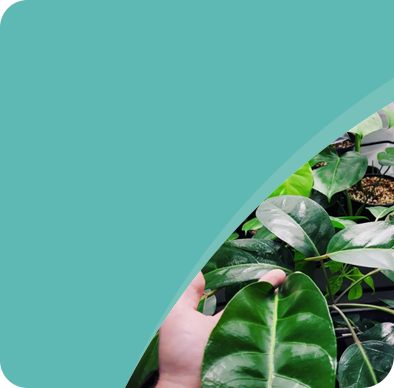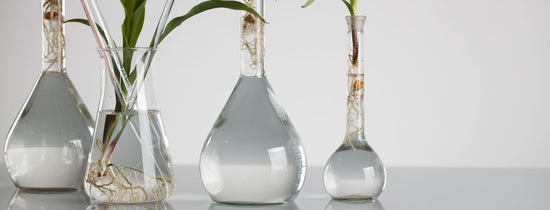What is EC? Electrical conductivity or EC is the measurement of the positive and negative ions in solution.
To put it more simply EC indicates the strength of nutrients added to water and mixed. The more nutrient you add to your water the higher the EC will be.
EC is the universal measurement used in assessing how much nutrient to give a plant at any given point in its life cycle.
As plants grow they require greater quantities of food to stay strong and healthy, young plants will usually require much less plant food whereas fully mature plants require a higher dose of these hydroponic nutrients.
Most hydroponic nutrient brands will have EC and dosage information on their labels.
For horticultural purposes EC is the most accurate way to measure the concentration of hydroponic nutrients in your water.
There are other ways of determining the concentration of nutrients in water those measurement terms are Parts Per Million (PPM), Total Dissolved Solid (TDS) and Concentration Factor (CF).
What is pH?
Potential of Hydrogen or pH in hydroponics is the measurement of water and nutrients to see how acidic or alkaline it is.
Understanding and managing the pH of your nutrient solution is extremely important when growing hydroponically.
Why is pH Important?
The pH of your hydroponic solution must be in range so the plants roots can access macro and micro elements that are transported throughout the plant, if this pH number is outside the required range then certain nutrients will just not be available for the plant to uptake.
Think of pH as a straw and the hydroponic nutrients as a milkshake. If you squeeze the straw (pH out of range) and try and to consume the milkshake it is going to be very difficult for you to consume, by releasing the straw (pH now in range) the milkshake flows easily.
This is the same principle for plants and the way their roots work;
- If the pH is always in range then food is always flowing freely.
- If the pH is out of range then food is not flowing freely.
How do I change the pH of my Nutrient Solution?
So, you have just made up a hydroponic nutrient mix to feed your plants but your pH meter tells you that the pH is much higher than you need it to be and you now need to adjust it.
pH is easily adjusted by using a ‘pH Up’ or pH Down’ solution sold at all good hydroponics equipment stores. (if you're unsure if you have a hydroponics shop nearby just google hydroponics shops near me or alternatively just order these products online)
How long should I leave my lights on?
This depends on the type of plant your are growing.
If you are growing auto flowering plants (aka day-neutral plants) and do not require a photoperiod, the suggested amount of light hours for autoflowers is generally 12-16 hours per day.
If you are growing short day plants or 'photos' then you'll need a specific amount of light hours to vegetate the plant. In these cases it is 18 hours of light and 6 hours of darkness; commonly referred to as 18/6.
When you are ready to flower 'photos' you'll need to adjust your light timer to 12/12 which is 12 hours of darkness and 12 hours of light.
For more technical info on how this works check out our DLI blog.
For more info on light values per crop check out this blog.Does the nutrient solution need to be heated?
In most cases no, but when winter comes around its a factor you now need to pay a little more attention too - For optimum growth, it is best to maintain your nutrient solution at a temperature of between 18.5 – 22.5°C.
What causes leaves to turn yellow?
Yellowing leaves can be caused by a number of factors:
- Low oxygen levels due to lack of aeration
- A nutrient deficiency.
- The pH is out of range.
- The solution is too hot or too cold.
- EC too high or low
All of these problems prevent the plant from absorbing nutrients in the correct quantities, by using an EC meter and a pH pen you can prevent this from happening with a little more confidence.
Why do plants stretch?
There are many reasons why a plant stretches.
- The light source is insufficient.
- Excess heat, causing stress.
- Excess humidity causing stress.
- The plant has begun to flower. (this stretch is totally normal for approx. 21 days or so)
What Humidity (RH) should I maintain?
- Vegetating/growth: 60-65%
- Flowering/bloom: 50-55%
- Drying: 50-55%
- Curing/storing: 55-62%
Using a hygrometer device mounted on the wall inside your hydroponic grow room will let you know at a quick glance what your humidity levels are. Humidity levels of just above 50% during flower is perfect and should not go above this. It is important to keep nutrient reservoirs covered at all times so that they do not contribute to higher humidity levels.
What Temp should the Grow Room be?
While the lights are on temperatures should be maintained between 22-28°C.
When the lights are off the optimum temperature range is 19-22°C.
The main device for regulating temperature and humidity in the grow room will be a quality ventilation system.
Is it necessary to aerate the nutrient solution?
Aerating the nutrient solution is a good idea.
It guards against stagnant nutrient solutions, improves root health and prevents bacterial infections.
A bubbling nutrient solution will last much longer than one that is sitting flat, and is easily managed with a quality air pump.
Generally speaking, if you are running a recirculating hydroponic system or intend to store a nutrient solution for more than 48 hours you should be aerating your nutrient solution.
How long for Clones to get roots?
The time taken to strike roots on clones varies according to the time of the year and the health of the clones and whether the method is manual or assisted about 5-12 days is usual for most manual methods.
Assisted methods include cloning machines that drastically speed up oxygen intake which in turn can force roots to form with 3-7 days.
Which type of LED grow light should I use?
The choice of grow light used in your grow room will arguably be your most important decision when setting your space.
If you shortcut on this decision to save money you'll effectively have inferior results. The sheer amount of fancy looking LED grow lights with amazing packaging are through the roof and for the most part they are all re-rinses of each other, copies of good lights but with cheaper parts.
Stay well away from them.
Go into a hydroponics shop get their advice and see what they have, do your research on them, check out non-bias reviews done by Lighting Gurus and take your time.
A hydro shop selling 11 different LED grow light brands quite simply only want your money and quite clearly only want to make a sale. A hydroponics store with a limited range is where you need to look. They are the ones who need your repeat business as they care about what they sell and generally test everything that goes on the shelves.
That wraps up the most common questions for 22/23 so far, if you have anything to say or you have a question not addressed in this blog, comment below. Happy Growing! #growwithus







